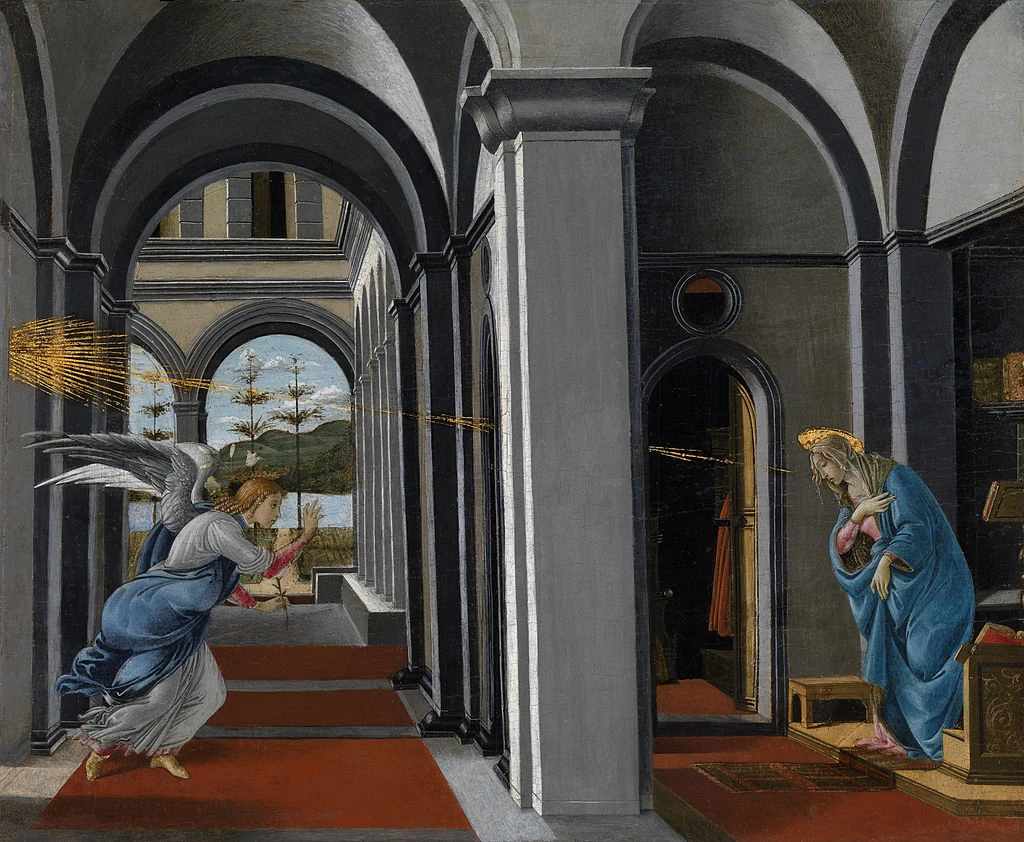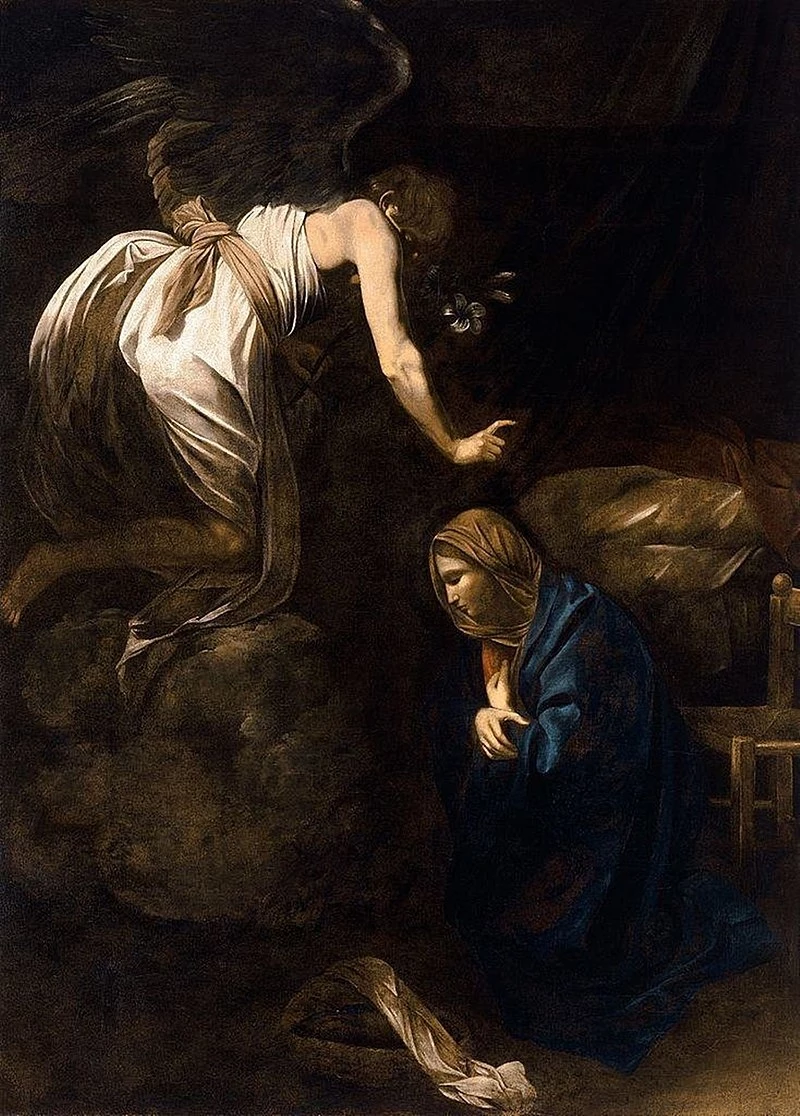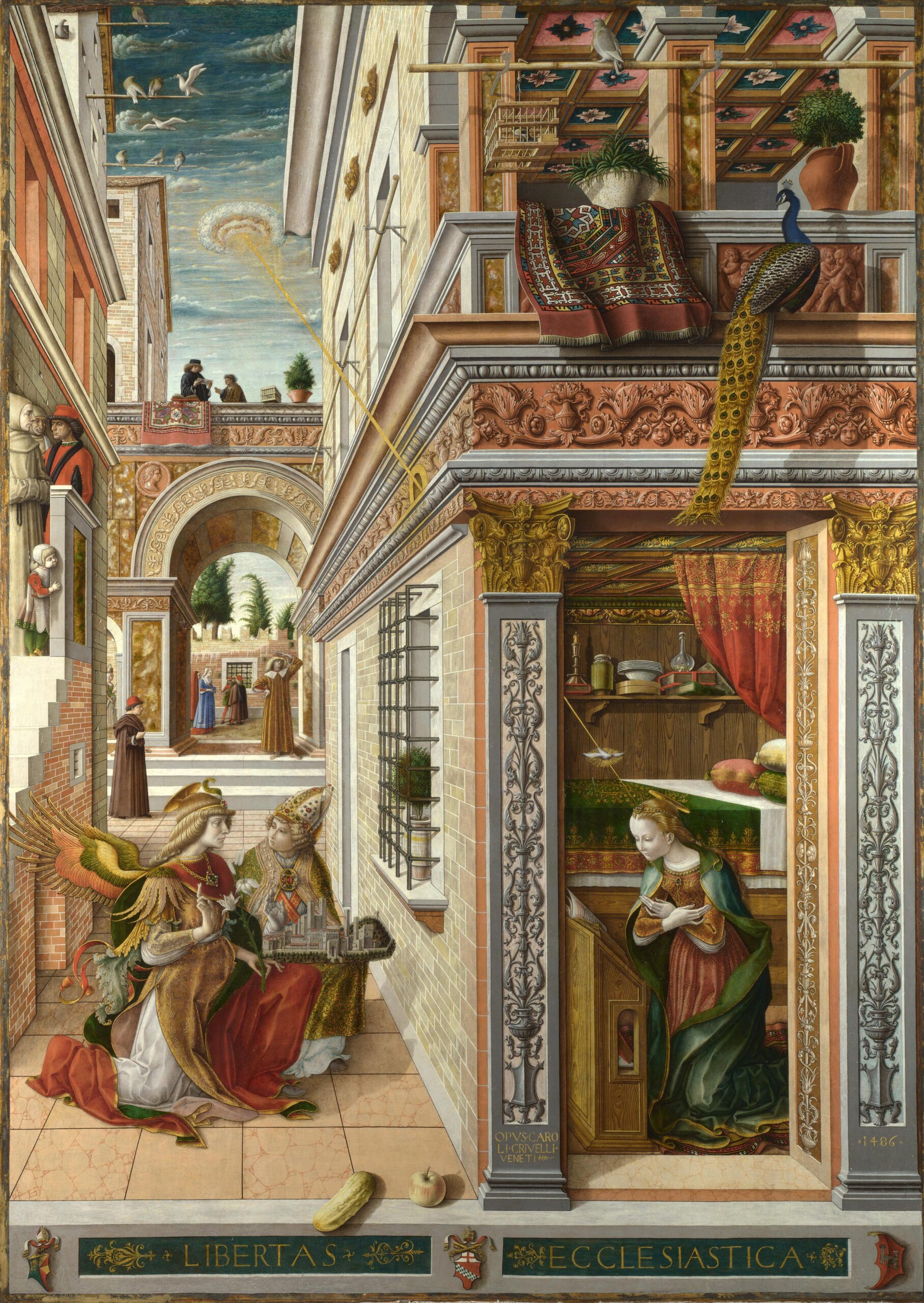Famous Angel Paintings of the Annunciation
The Annunciation is a key topic in church decoration of the early Christian and medieval periods, as well as in the religious art of the Renaissance and the Baroque period. And there are countless great Annunciation paintings from various times and styles. Works on the subject have been created by artists such as Sandro Botticelli, Leonardo da Vinci, Caravaggio, Jan van Eyck, and Murillo. Many of them several times.
In this article, I’d like to share some of the most famous angel paintings of the Annunciation. If any amazing Annunciation art paintings are missing, feel free to add them in the comments.
- What is the Annunciation of the Lord?
- Famous Annunciation paintings
- 1. The Annunciation (Fra Angelico, San Marco)
- 2. Cestello Annunciation
- 3.Annunciation (Leonardo)
- 4. Annunciation (van Eyck, Washington)
- 5. Annunciation by Petrus Christus
- 6. The Annunciation by Caravaggio
- 7. The Annunciation, with Saint Emidius
- 8. Annunciation (Filippo Lippi, London)
- 9. The Annunciation (Bartolomé Esteban Murillo)
- 10. Ecce Ancilla Domini
- Conclusion
- Additional angels articles
What is the Annunciation of the Lord?
The Annunciation is also called the Annunciation to the Blessed Virgin Mary, the Annunciation of Our Lady, or the Annunciation of the Lord. It refers to the historical event where the archangel Gabriel appeared to the Virgin Mary and told her that God had selected her to be the mother of Jesus.
Famous Annunciation paintings
1. The Annunciation (Fra Angelico, San Marco)

The Annunciation is not Fra Angelico’s first painting on that theme. There are at least 4 versions and the Annunciation that Fra Angelico painted for the north corridor of the San Marco convent is arguably his finest version of this traditional theme.
This artwork was made between 1440 and 1445, and it is still considered to be one of the best-preserved fresco paintings to this day.
The thing I love most about Fra Angelico’s Annunciation is that the wings sparkle when you see it in person. Photos can’t capture it, so when you see it in person for the first time it’s a real shocker!



2. Cestello Annunciation

The Cestello Annunciation is a masterpiece by the Italian painter Sandro Botticelli, created around 1489-1490. The painting is currently in the Uffizi Gallery in Florence, Italy. The painting was originally commissioned for the church of Cestello in Florence. Hence the name “Cestello Annunciation”.
The painting represents the moment the Archangel Gabriel informs the Virgin Mary that she has been selected to be Jesus’ mother. Gabriel is depicted kneeling in front of Mary, his wings spread out behind him, holding a stem of lilies, a symbol of Mary’s purity. Mary is seated on a chair, her head lowered in prayer and her hands outstretched. She is dressed in a blue robe and a scarlet cloak, both of which signify her purity.
The painting was made using the technique of tempera on panel. Botticelli uses a characteristic style of the early Italian Renaissance, with great emphasis on linear perspective and meticulous attention to detail. The construction of the room and the arrangement of the characters in it allow the viewer to appreciate the depth and three-dimensional space.
In this painting, you can see natural elements such as plants and flowers in the garden behind the Virgin Mary. This could be a reference to the connection between nature and divine life, a recurring theme in Renaissance art.
Without a doubt, Sandro Botticelli’s Cestello Annunciation is a work of art rich in detail and symbolism, reflecting the style and skill of the artist of his time. Botticelli also painted a 1485 Annunciation now in the Metropolitan Museum of Art and a 1495-1500 version now housed in the Kelvingrove Art Gallery and Museum.


3.Annunciation (Leonardo)

Leonardo da Vinci’s Annunciation is one of the most celebrated Renaissance paintings.
The painting illustrates the Archangel Gabriel on his knees with his right hand raised towards Mary in greeting in the Florentine palace garden. holds a white lily in his left hand, which represents Mary’s virginity as well as the city of Florence. Mary is depicted with her left-hand gesture in response to the archangel’s greeting. The height, width, and depth of the painting all meet in Mary’s spot with Mary’s body outlined by the house’s comer stones and her head emphasized by the dark wall. Mary’s importance is signified in the painting.
The marble table in front of Mary probably is derived from the tomb of Piero and Giovanni de’ Medici in the Basilica of San Lorenzo, Florence, which Verrocchio had sculpted during this same period.
The Annunciation is generally considered to be one of Leonardo’s youthful works, painted when he was still working in the studio of Andrea del Verrocchio.
Although this is the earliest known commissioned painting by Leonardo, it has been pointed out that the painting already bears characteristics that are described as demonstrating the signature innovations he introduced in his paintings: sfumato and atmospheric perspective.
4. Annunciation (van Eyck, Washington)

Jan van Eyck’s Annunciation is an incredible oil painting from the early Dutch period. It is a separate panel that may have once been part of a triptych (three-panel altarpiece).
Gabriel is depicted in the painting to the side of Mary, his wings stretched out behind him. He is holding a scepter, which indicates his authority, while his other hand is pointing to the heavens. Mary is depicted seated, her hands open in prayer and a book on her lap.
The setting is a Gothic-style room with a marble floor and finely sculpted architecture. In the background, there is a wooden bench and a potted plant.
This painting is regarded as one of the greatest masterpieces of Northern Renaissance art for its use of perspective and meticulous details, such as the reflections on the marble floor and the individual strands of hair on the heads of the people.
Jan van Eyck’s alternate version of the Annunciation is also very impressive. Here, van Eyck deliberately rejects the use of primary colors, painting the figures in white on a black background to create the illusion of a sculptural group.

5. Annunciation by Petrus Christus
There are two famous versions of Petrus Christus’s Annunciation. One is in The Metropolitan Museum of Art, and the other is in the Groeninge Museum, Bruges.

This Annunciation transforms the laconic narrative of the Bible into a kind of visual poem. The angel wears the liturgical vestments of a priest, and the Virgin Mary is sheltered at the door of a church that is Romanesque (right) and Gothic (left), marking the transition from Old to New Testament. It is exceptional for its bird’s-eye view and outdoor setting. Also known for its meticulous observation of plant life.
Another version is famous for its sophisticated and detailed composition that draws the viewer in with its beauty and soulfulness.

The angel’s annunciation to Mary takes place inside a Gothic church. Through an open door at the bottom, it connects with the outside world. The stained-glass window in the background depicts the Coronation of the Virgin Mary, as well as a vase of white lilies and the ivory tower of the Song of Songs, symbols of Mary’s purity and the Immaculate Conception. In the half-point stone arcade, which functions as a window to the scene, there are four scenes from the history of Mary carved in white stone: the Annunciation in Sant Joaquim, the meeting at the Golden Gate, and the birth and presentation of Mary in the Temple. All four are flanked by images of two prophets to the left and right.
6. The Annunciation by Caravaggio

The painting consists of two figures, the Archangel Gabriel and the Virgin Mary. Gabriel is the angel of the Annunciation and the flowers on his hand are also a symbol of the Virgin.
The artwork features Caravaggio’s distinctive sfumato and tenebrism, except for the two major figures, virtually the entire canvas is dark. The loose brushwork is a characteristic of Caravaggio’s later period.
7. The Annunciation, with Saint Emidius

The Annunciation, with Saint Emidius, is an altarpiece by Italian artist Carlo Crivelli showing an artistic adaptation of the Annunciation. Crivelli’s version rather peculiarly places Gabriel outside the Virgin’s home, accompanied, in another unusual variation on the theme, by St. Emidius.
Gabriel descends to tell the Virgin that she is to bear a child – a moment known as the Annunciation – but has been distracted from his mission by a bishop saint, who has stopped him in the street of a Renaissance town. This is Saint Emidius, patron saint of the town of Ascoli Piceno in the Italian Marches. This painting is unique in showing a local saint effectively intervening in a biblical event.
8. Annunciation (Filippo Lippi, London)

The Annunciation is a tempera on panel painting by the Italian Renaissance master Filippo Lippi that dates from around 1449-1459 and is housed in the National Gallery in London.
Except for this version, there are several versions of The Annunciation by Filippo Lippi.





9. The Annunciation (Bartolomé Esteban Murillo)

The Annunciation is an oil painting on canvas by Bartolomé Esteban Murillo. Murillo is a representative painter of the Spanish Golden Age, a period in which Spanish art was internationally acclaimed.
In this painting, Maria is a very young woman with an almost childlike face. She kneels before the altar and gazes down contemplatively. She lowered the basket in her hand as if she had been disturbed by an angel in her prayers. Even an angel seemed a very earthly creature, if not for the presence of his wings. He was not floating in some indeterminate space, nor was he a vision, but he was kneeling on the tiles of the floor. He was strong-limbed and barefoot, almost like a peasant, with a pretty face framed by dark hair. With one hand he pointed to the dove of the Holy Spirit, which floated above their heads, a truly transcendent, formless, celestial vision. The other hand makes a gesture of persuasion: he seems to be desperately trying to explain his mission to Mary.
Mary’s innocence is set off so strongly by the lilies, which symbolize purity, that the viewer can sense her quiet reserve, her excited anticipation of the prophesied miracle, and her amazement at the experience.
10. Ecce Ancilla Domini

Rossetti presented an unconventional depiction of the Annunciation. Traditionally the Virgin was depicted in studious contemplation, reading a missal at a prie-dieu; but here Rossetti shows her rising awkwardly from a low bed, as if disturbed from sleep, while the Angel Gabriel presents her with a white lily.
He deliberately used a limited color range for this oil painting. The predominance of white, symbolic of virginity, is complemented by vibrant blue and red, for Christ’s blood. Lilies are traditionally the symbol of Mary in Italian Renaissance art.
Though this painting received mixed reviews, it is still a brilliant work.
Conclusion
The Annunciation in art was a popular subject from the 14th to the 17th centuries, especially in European art, where most artists were Christian. Today, you problly seen people top their Christmas trees with decorative angels, which comes from the sight shown in the Annunciation: Angels visited Joseph and the Virgin Mary about the upcoming birth of Jesus, and on the night of his birth, angels appeared in the sky over Bethlehem to announce his arrival to the world.
